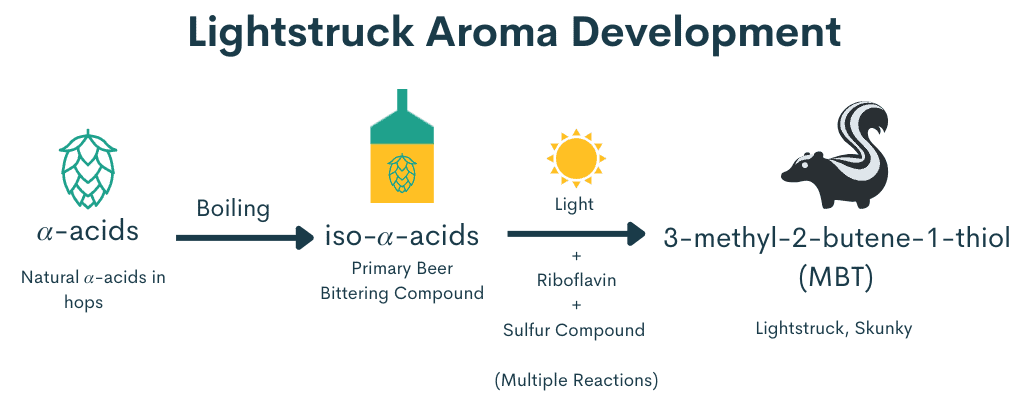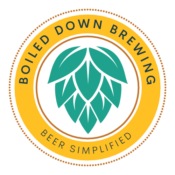Many beer drinkers have had the experience of ordering a pint of beer mid-summer while sitting outside in the sun only to find that about halfway through drinking the beer, it suddenly has a skunky smell, a beer off-aroma called lightstruck in the brewing community.
But how is it that a beer that tastes and smells perfectly fine when poured is suddenly transformed into something that smells like skunk spray after contact with light?
Boiled Down Summary
- Lightstruck (or skunky) aroma in beer is primarily caused by 3-methyl-2-butene-1-thiol (MBT), a thiol produced by the decomposition of iso-𝛼-acids (the bittering component of beer) in the presence of light, riboflavin, and a sulfur-containing compound.
- MBT has a low perception threshold in beer and is described as similar to skunk spray.
- Brewers, retailers, and consumers can limit MBT formation by preventing light contact with beer.
What causes skunky beer aroma?
The idea of lightstruck aroma in beer has been around for over 100 years. Dr. Carl Lintner first wrote about the concept in 1875, and in the 1960s, 3-methyl-2-butene-1-thiol (MBT) was first suggested as the cause of lightstruck aroma in beer (Oliver, 2013, pp 548). Today, it is generally accepted that the key contributor to lightstruck aroma in beer is MBT. However, other compounds are also thought to contribute to lightstruck aroma to some degree. MBT smells similar to the defensive spray of skunks (Oliver, 2013, pp 548), which is why lightstruck beer is often described as “skunky.”
MBT is formed by the photodegradation of iso-𝛼-acids in the presence of riboflavin and sulfur-containing compounds (Bamforth, 2006, pp. 169-170). More simply, lightstruck beer is caused by the interaction of light with iso-𝛼-acids, the primary bittering compound in beer from hops, when riboflavin and sulfur compounds are also there. To learn more about hops and 𝛼-acids, view this article.
Below is a simplified diagram that shows the basics of MBT formation in beer.

De Keukeleire et al. (2008) also showed that it is possible to form MBT in beer from iso-𝛼-acids without riboflavin via UV light wavelengths.
Perception of MBT in beer
The flavor perception threshold for MBT is very low, with Bamforth (2006) stating a perception range of just 0.4 – 45 ng/L of beer.
For perspective, imagine a beer the size of the Empire State Building, which is 37 million cubic feet or approximately 1 billion liters in volume. At the lower threshold of 0.4 ng/L of MBT to make a beer smell lightstruck, it would take just 0.4 grams, or less than 1/8 teaspoon, required in that 1 billion liter beer to make it smell lightstruck. Isohumulones (iso-𝛼-acids) in beer typically range from 10 – 100 mg/L in beer (De Keukeleire et al., 2008), so a tiny proportion of the iso-𝛼-acids need to be converted to MBT for detection.

Consumers are also able to perceive lightstruck characteristics and show a preference for beers that are not lightstruck. Stephenson and Bamforth (2002) conducted a consumer study where they presented tasters with two examples of the same imported lager beer and asked them to indicate their preference.
One example was the beer as-is, and one example was the same lager put in direct sunlight for six hours to develop lightstruck flavor. Tasters in this study preferred the fresh beer to the lightstruck beer, although it is interesting that some in the study preferred the lightstruck example.
Preventing skunky beer
Brewers have a range of ways to reduce the possibility of skunky, lightstruck beer.
Brewers can choose how they package their beer. The simplest way to prevent lightstruck aroma is to keep beer away from lights. Cans and kegs are opaque, so they completely shield beer from light. For bottles, glass color choice can impact what light gets to the beer. 350-500 nm wavelength light is the most damaging to beer (Kunze, 2019, p. 541), and brown glass is the best at stopping those wavelengths. Green glass offers limited light protection, and clear glass transmits nearly all light into the bottle.
However, there are still beers bottled in clear and green glass on the market that do not seem to be skunky, so how is that possible? Brewers can also choose hop products that are more light stable.
Some advanced hop products also offer protection from MBT formation by using reduced iso-𝛼-acids forms like rho-iso-𝛼-acids that do not transform to MBT in the presence of light. To learn more about advanced hop products and see what is available on the market, check out hop suppliers like Haas.
Retailers and consumers can also help prevent skunky beer by ensuring minimum contact with light, including during transport and storage.
References
Bamforth, C. W. (2006). Scientific Principles of Malting and Brewing. American Society of Brewing Chemists.
Burns, C. S., Heyerick, A., De Keukeleire, D., & Forbes, M. D. E. (2001). Mechanism for formation of the lightstruck flavor in beer revealed by time-resolved electron paramagnetic resonance. Chemistry – A European Journal, 7(21), 4553-4561. https://doi.org/10.1002/1521-3765(20011105)7:21%3C4553::AID-CHEM4553%3E3.0.CO;2-0
De Keukeleire, D., Heyerick, A., Huvaere, K., Skibsted, L. H., & Andersen, M. L. (2008). Beer Lightstruck Flavor: The Full Story. 33(3).
Empire State Building Fact Sheet. The Empire State Building. https://www.esbnyc.com/sites/default/files/esb_fact_sheet_4_9_14_4.pdf
Kunze, W. (2019). Technology Brewing and Malting (6th ed.). VLB Berlin.
Oliver, G. (2012). The Oxford Companion to Beer. Oxford University Press.
Stephenson, W., & Bamforth, C. (2002). The Impact of Lightstruck and Stale Character in Beers on their Perceived Quality: A Consumer Study. Journal of the Institute of Brewing, 108(4), 406–409. https://doi.org/10.1002/j.2050-0416.2002.tb00568.x

